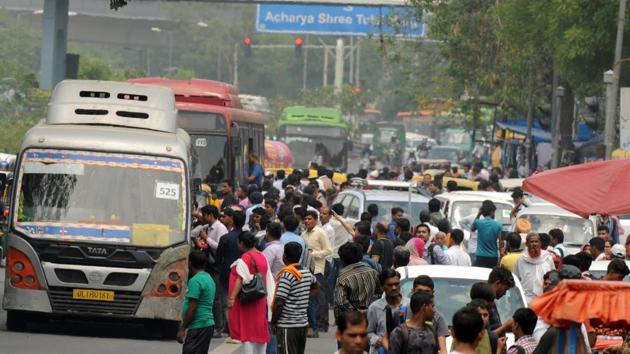Making real time transit data public best bet to boost Gurugram’s bus service
Gurugam’s bus service - Gurugraman - can address the issue of optimal usage by addressing problems around frequency, route, timings by disseminating information to consumers or by opening up its data and using private sector.
The disruption in Metro service during the morning rush hour on Tuesday exposed how lacking are Gurugram’s public transport facilities. People had to walk long distances, and many reported late at work. Yes, these stranded passengers could have used a bus system instead, if Gurugram had one. Remember, when hurricane Sandy hit New York in 2012 the subway system was not operational for weeks? That’s when the city’s bus system came to its rescue.

Though Gurugaman, city’s bus service, added another route last week, it still has a long way to go. The average daily readership on the city bus network is around 25,000 passengers. This means that before the addition of the new route, on an average, one city bus carried around 330 passengers per day. This shows that the system is grossly underutilised. Yes, the low ridership is also due the fact that the system is not fully developed. Once fully operational, the city bus network will see 500 buses on 25 different routes and result in ridership growth.
However, this may still not address the question of optimal usage because the system needs to address some key issues around routing, frequency, and timings of the service. The Gurugram’s city bus network can address these issues by either following the traditional approach of providing the information to the consumers or by opening up its data and using private sector do the provisioning. The latter approach—of opening up the transit data—is worth exploring. Let me explain why.
Provide real-time info
Public transport data, such as bus routes, schedules, etc, are important in ensuring high usage of the service. This information also impacts the experience of customers which is important in a city like Gurugram because the lack of such information forces people to use alternative modes of transport, such as personal vehicles. Therefore, opening up of transit data can lead to the provisioning of such information to users on a real-time basis. This results in higher usage of the system.
For example, when the city of New York opened up its transit data to the public, it saw a significant increase in bus ridership and therefore increase in revenue for the public transport operators. With the open transit data, people could get real-time information of arrival/departure and could plan their travel more precisely.
Crowdsourcing
India is seeing a huge surge in the sale of cellphones and a rapid rise in consumption of data. A report by networking giant Cisco suggests that while only 27% Indians were using smartphones till 2017, the number is expected to double by 2022. Gurugram can leverage this phenomenon. As our public agencies are not the best when it comes to using new technology, the internet or creating mobile applications, it would be prudent if they just opened up the realtime operations data and let the private sector do the rest like create applications to satisfy the needs of various category of users. For example, someone with visual impairment can access solution provided by voice, rather than an image. Similarly, other innovative solutions can be developed.
Saves public money
If government agencies try to provide the same level of information, it will not work. This is because they neither have the capacity nor the money. For example, when Transport for London (TFL) opened its transit data, more than 500 apps were developed. These apps were catering to more than 4 million users per day. It is estimated that if TFL would have provided the same level of information to that many customers, it would have easily cost them more than 40 million pounds, that’s a lot of money. Therefore, it is best to leverage the existing ecosystem of entrepreneurs and technology companies to provide the information which will be more useful and targeted and won’t even cost public agencies a fortune.
Daniel Keys Moran, the American computer programmer and science fiction writer, once said: “You can have data without information, but you cannot have information without data”.
Therefore, once agencies in Gurugram open up the public transport data on a real-time basis, it will be a game changer for users as they will get effective information to plan their trips. In addition, the public transport agencies will also be surprised by the wealth of information that this data will generate for them and how they can benefit from it.
(Amit Bhatt is the director- integrated transport, WRI India)
Stay updated with all the Breaking News and Latest News from Mumbai. Click here for comprehensive coverage of top Cities including Bengaluru, Delhi, Hyderabad, and more across India along with Stay informed on the latest happenings in World News.
Stay updated with all the Breaking News and Latest News from Mumbai. Click here for comprehensive coverage of top Cities including Bengaluru, Delhi, Hyderabad, and more across India along with Stay informed on the latest happenings in World News.






